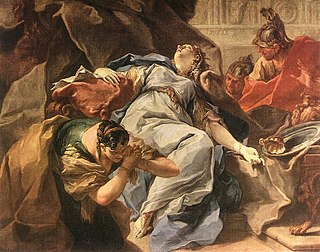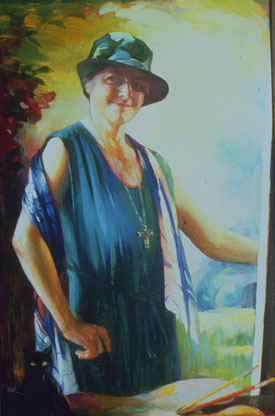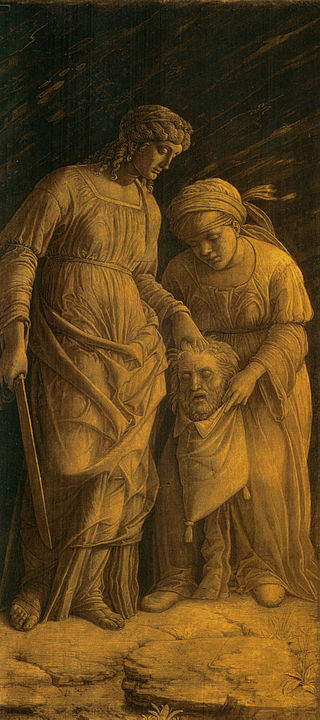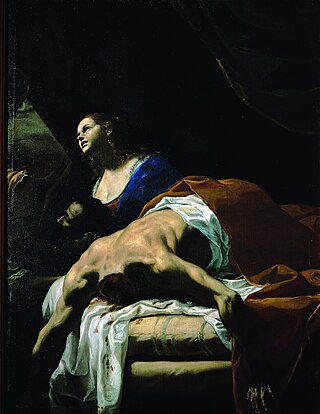The Death of Sophonisba is the name of the following paintings:
- The Death of Sophonisba (Pittoni), a 1716–1720 oil-on-canvas painting by Giambattista Pittoni
- The Death of Sophonisba (Preti), a 1670s painting by Mattia Preti
The Death of Sophonisba is the name of the following paintings:

Sofonisba Anguissola, also known as Sophonisba Angussola or Sophonisba Anguisciola, was an Italian Renaissance painter born in Cremona to a relatively poor noble family. She received a well-rounded education that included the fine arts, and her apprenticeship with local painters set a precedent for women to be accepted as students of art. As a young woman, Anguissola traveled to Rome where she was introduced to Michelangelo, who immediately recognized her talent, and to Milan, where she painted the Duke of Alba. The Spanish queen, Elizabeth of Valois, was a keen amateur painter and in 1559 Anguissola was recruited to go to Madrid as her tutor, with the rank of lady-in-waiting. She later became an official court painter to the king, Philip II, and adapted her style to the more formal requirements of official portraits for the Spanish court. After the queen's death, Philip helped arrange an aristocratic marriage for her. She moved to Sicily, and later Pisa and Genoa, where she continued to practice as a leading portrait painter.

The Walker Art Gallery is an art gallery in Liverpool, which houses one of the largest art collections in England outside London. It is part of the National Museums Liverpool group.

Sophonisba was a Carthaginian noblewoman who lived during the Second Punic War, and the daughter of Hasdrubal Gisco. She held influence over the Numidian political landscape, convincing king Syphax to change sides during the war, and later, in an act that became legendary, she poisoned herself rather than be humiliated in a Roman triumph.

The Gallerie dell'Accademia is a museum gallery of pre-19th-century art in Venice, northern Italy. It is housed in the Scuola della Carità on the south bank of the Grand Canal, within the sestiere of Dorsoduro. It was originally the gallery of the Accademia di Belle Arti di Venezia, the art academy of Venice, from which it became independent in 1879, and for which the Ponte dell'Accademia and the Accademia boat landing station for the vaporetto water bus are named. The two institutions remained in the same building until 2004, when the art school moved to the Ospedale degli Incurabili.

Giambattista Pittoni or Giovanni Battista Pittoni was a Venetian painter of the late Baroque or Rococo period. He was among the founders of the Academy of Fine Arts of Venice, of which in 1758 he became the second president, succeeding Tiepolo.

Mattia Preti was an Italian Baroque artist who worked in Italy and Malta. He was appointed a Member of the Order of Saint John.
Christ and the Woman Taken in Adultery is an incident from the New Testament.

Ella Sophonisba Hergesheimer was an American illustrator, painter, and printmaker who painted and illustrated Tennessee society, including the state's women and children. As a printmaker, she pioneered the white-line woodcut.
Judith and Holofernes may refer to:

Exemplary Women of Antiquity is a set of paintings produced between 1495 and 1500 by Andrea Mantegna. They show the Carthaginian noblewoman Sophonisba poisoning herself to avoid being paraded in a Roman triumph, the Roman Vestal Virgin Tuccia proving her chastity by carrying water in a sieve, Judith with the head of Holofernes and Dido holding Sychaeus's funeral urn. Infrared reflectography has uncovered a signature on the back of Judith reading And.a Mantegnia. P[inxit].. Sophonisba and Tuccia are egg-tempera on poplar panel, whilst Judith and Dido are glue-tempera on linen canvas.

The Death of Sophonisba or Sophonisba Taking Poison is a 1670s painting by Mattia Preti depicting the suicide of Sophonisba in Ancient Carthage. It is held in the Museum of Fine Arts of Lyon.
Sophonisba was a Carthaginian noblewoman.

Judith and Holofernes is an oil on canvas painting by Italian artist Mattia Preti, datable to around 1653–1656. It is held at the Museo di Capodimonte, in Naples.
Christ and the Canaanite Woman may refer to one of two paintings of the exorcism of the Syrophoenician woman's daughter:
The Four Evangelists may refer to one of two paintings:

The Death of Sophonisba is a 1716–1720 oil on canvas painting of Sophonisba by Giambattista Pittoni, produced in Venice - a sketch or smaller copy was bought by the Gemäldegalerie Alte Meister in 1723. It was bought for the Hermitage Museum in 1773 by the court cellist G. Dal Olio, then placed in the Tauride Palace. It was auctioned by Tsar Nicholas I in 1854 and bought by E.T. Zarudnoi-Cavos, then bought back by the Hermitage Museum in 1918. It was finally transferred to its present home at the Pushkin Museum in 1930. Its pair a Semiramis by the same artist, was in the Nikaelov collection in Paris before being bought by the Pushkin Museum in 1853.
Christ Giving the Keys to Saint Peter is the name of the following paintings:
The Vision of Saint Anthony of Padua is the name of the following paintings:
Saint Anthony with the Christ Child is the name of the following paintings: